Publishing content intentionally derived from ranking assessment in order to organically produce search traffic (SEO content) is the most effective way to increase your site’s consistent traffic growth. In short, developing a content strategy drives SEO results. Keyword-driven content topics with proven search demand, relevance to your product or your services, and audience interest strategically increase your traffic, which is why SEO content is essential. Successful SEO content strategy targets the content topics oriented in relevant, intent-driven keywords with proven search demand.
The intention of this post is to help you through the process of finding the right keywords and transforming them into SEO content that ignites growth for your website. The intended outcome of this revamped content strategy is to facilitate organic search traffic on a consistent and sustained basis.
Table of Contents
Step One: Find Your Target SEO Keywords
Despite claims in recent articles that “keywords are dead,” finding the right keywords to target continues to be the first important step in any SEO content strategy. Citing semantic searching and Google’s improved understanding of natural language as factors in reduced keyword value, some assert that keywords are no longer as significant to SEO.

Although Google has improved in understanding “things not strings,” its refinement doesn’t correspond to the demise of keywords. Since Google continues to grow smarter through understanding things via algorithm updates, like the Bert update, and increasingly serves results based on machine learning, SEO keywords remain essential.
Here are six significant functions of SEO keywords:
1. Informing Topics
Researching keywords is one of the most effective methods for uncovering new SEO opportunities and an initial step in topic development. As seeds for topic development, keywords significantly influence content topic ideas.
2. Gauging Demand
Since one primary purpose of SEO is increasing qualified traffic, finding keywords with proven search demand is critical in determining the market for your SEO keyword-driven topics.
3. Understanding Intent
Keywords increase your understanding of the searcher and their goals. Whether they are gathering information, looking for a product, or trying to solve a problem, your understanding of their search intent impacts the types of content to create.
4. Measuring Difficulty
Generally, the greater the monthly search volume, the more difficult it is to rank for a keyword. Before you decide to target a particular keyword, you need to know if you can outrank competitors on that keyword topic.
5. Prioritizing Topics
One KPI that is helpful in prioritizing content topics is keyword popularity. From the significant pool of potentially valuable content topics, leveraging search volume supports your ability to prioritize the most relevant SEO-driven ideas.
6. Tracking Performance
By tracking and monitoring rankings for your target keywords, you can evaluate the performance of your SEO content through the SERPs (search engine results pages). With this opportunity to assess the value of your content in mind, the following importance of keyword selection can’t be emphasized enough.
| Finding the right keywords to target is the single most important first step in your SEO content strategy. If you don’t have a list of relevant, traffic-driving keywords, you don’t have an SEO content strategy. |
SEO Content Keyword Research Tools and Tutorials
Knowing the importance of keywords, you can begin researching keywords with one of these free or paid tools, which are some of the best in the industry.
- Google Keyword Planner
- Google Search Console
- Moz Keyword Explorer (paid)
- Moz Keyword Difficulty Tool (paid)
- Google Trends
- Google Auto Suggest
- Ahrefs Keywords Explorer (paid)
- SEMrush Keyword Research (see our in-depth review of SEMrush)
- KeywordTool.io
- GrepWords (paid)
- Ubersuggest
- Term Explorer (paid)
- KWfinder
- Serpstat
- Bing Webmaster
Starting with Google Keyword Planner is a great choice, because it’s free and provides a plethora of keyword ideas.
For variety or determining any gaps in a content strategy, try using another tool on the list to see if any ideas have been missed during the initial Keyword Planner exploration. Since all of the tools draw from similar data sources, using two or three tools will give you the information you need; you don’t need to use all of the tools on this list.
In this first stage, the objective is to find keywords to target that are most relevant to your product, your service, or your industry. Once a list of keywords is created, use these terms as the foundation for your content topics.
For additional support when beginning the keyword research process, the following posts provide further information on keyword research and related tutorials.
- Keyword Research – The Advanced Guide to SEO
- Keyword Research for SEO: The Definitive Guide
- How To Do Keyword Research – The Beginners Guide to SEO
- Google Didn’t Intend For SEO’s To Use The Keyword Planner This Way
- 12 Keyword Research Tools and Creative Ways to Use Them
Analysis of Competitors’ Websites
In addition to using the available keyword research tools to determine which keywords to target, analyzing your competitors’ website can also help with this process. This strategy helps you identify which keywords your competition is using and assess top performing keywords that drive the most SEO traffic to their sites. Competitor analysis also provides support for topic idea development, as further addressed in Step 3: Brainstorming Tips and Tools for Topic Ideation. Since this article broadly overviews how to develop your SEO content strategy, additional support on executing analysis of your competition as part of the keyword research process is available in the in-depth articles below:
- SEO Competitor Analysis: Discover Your Competitor’s Keywords
- Keyword Competition Analysis (Chapter 5)
- How to Carry Out Detailed Competitor Keyword Analysis
Step Two: Build and Organize Keyword Lists
Cast a wide net and gather as many relevant keywords as possible when conducting keyword research, because more keywords means more topic opportunities. Since keyword research can be time-consuming and laborious, accumulating an abundance of topic opportunities now also saves you time later, since you won’t have to repeat the process as frequently.

Since your search scope is vast, staying organized is imperative in order to avoid drowning in a sea of keywords. Using a system to manage these lists of keywords and to actively group, refine, and iterate as you investigate will help you narrow bigger lists into core groups of your strongest keyword topic ideas.
Below, we’ve recommended how to build lists, categorize them, and then develop powerful content ideas from those topics.
Building Lists
To help you understand this process, we’ll model keyword list building using the following scenario:
Imagine we’re developing an SEO content strategy for a B2B SaaS company that sells sales management tools. C-level sales executives, sales directors, and managers are the target audience. Some relevant, core keywords or head terms that this company may pursue might include the following options:
- Sales software
- Sales management
- Enterprise sales
- Sales strategy
- Sales pitch(es)
Clearly, this list is not exhaustive, but we’ll use this set of core terms as the focus of our process modeling.
Next, run the core terms through a keyword tool (as per Step 1). These are the results from the Keyword Planner using “sales management” as the core term.
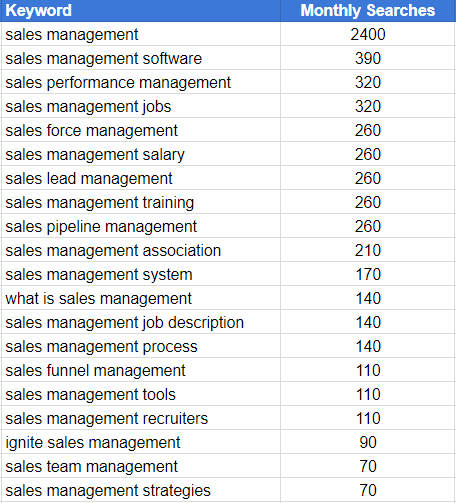
All these keywords are closely-related to our core term, and they are phrase match variations that range from mid to long-tail keywords. Results also include Google’s estimated monthly search volume, sorted from highest to lowest demand. Here is where the organization of documentation begins. At this point, results should be exported into a Google doc or Excel sheet under a dedicated tab or section labeled “sales management.” Since you’ll repeat this process with as many core terms as you have, you can see why organizing the content will ensure coverage of all terms, serve as a resource in the future, and save your sanity in the keyword research process.
Determining KPIs
As the primary KPI to consider during the list building phase, search volume indicates how popular and competitive a keyword is. Accordingly, it is one of the most important KPIs to use throughout the SEO content strategy process.
For an established website with organic search traffic, explore both keyword rankings and rankings page URL, two other KPIs, in addition to monthly search demand. With keyword rankings, include a column where the term already ranks, if the domain already ranks for a particular keyword(s) on the list. For ranking page URL, add a column to include the page that already ranks for that keyword in Google. For a fast and accurate rank tracking tool, Authority Labs is a valuable resource.
Analyzing Google rankings enables you to find opportunities and know where to focus your efforts, because they reveal quite a bit about the website. Returning to the example scenario will further illuminate the why/how of this reveal based on potential ranking circumstances.
| Circumstance #1: The site ranks well for a keyword(s). | Circumstance #2: The site ranks for the keyword, but it could rank better. | Circumstance #3: The site doesn’t rank at all. |
| If the site is already ranking page one for a term, it doesn’t make much sense to create additional content targeting a keyword topic that’s already successful. There are better opportunities for expansion and increasing traffic. | The action to take in this situation depends on where the site ranks. If it ranks page two or better with the keyword, try to improve rankings by reworking the page. If it ranks page three or lower, then creating new content may be the better choice.
Subpar rankings generally indicate flawed content or a page with no authority signals or low user engagement scores. It’s also possible that the content is just not informative enough to outrank the competition. Bottom line: review the content to salvage it or start from scratch. |
This is generally where you’ll find the best SEO content opportunities. |
Keyword rankings also provide a baseline measurement for continual progress tracking and assessment. Additional KPIs to evaluate after publishing your content, like organic traffic and conversions, are also important in monitoring progress.
To return to building out your list of keywords, another KPI to investigate in determining your keyword selections is keyword difficulty. Difficulty scores for keywords can be found using Ahrefs Keyword Explorer or the Moz Keyword Difficulty.
| When it comes to keyword difficulty, one prime area to focus on are terms in the “Goldilocks Zone:” keywords with not-too-much competition, and not-too-little search demand. This is a real sweet spot because the conditions are “just right.” You can often create content that that has the chance do well right of the gate for those target “sweet spot” keywords, particularly if the site has decent domain authority. |
Finally, other metrics like cost-per-click or trend data further help determine keywords to include on your list, but sometimes too many data points overly complicate this already nuanced research process. Assessing more KPIs doesn’t always result in actionable information when building out your keyword lists for your SEO content strategy.
Simplify your strategic SEO starting point: begin with search demand and rankings.

Scrubbing Your Keyword Lists
Thus far, using our sales software company model, the extensive keyword research has resulted in a ton of potential keyword topic opportunities that can be targeted across a range of different verticals, at every stage of the funnel. Although casting a wide net in this process is important, it’s done with the understanding that not all of these keywords will be a fit or ultimately used. Since a substantial amount of the keyword list building has been completed, it is now time to organize and refine the lists by reviewing the sales-focused keywords and purging items on the list based on relevance, scope, or competition. Here are some considerations for potential keywords to discard:
* Keyword isn’t relevant. Remove terms from the list that aren’t relevant to the site or its associated services, products, industry, or intended audience.
* Keyword is too broad or too general. These terms are not only incredibly competitive but are also less likely to yield qualified traffic.
* Keyword is too competitive. Remember: the higher the search demand, the harder a term is to rank for. More authoritative domains have a better chance to compete and rank well. Setting a threshold that pits search demand against Moz domain authority can help you determine if a keyword is worth the investment.
Returning to the example list of sales management keywords, here’s how this review and purge process looks. Note the keywords highlighted in red which indicate that they should be pulled from the final list.
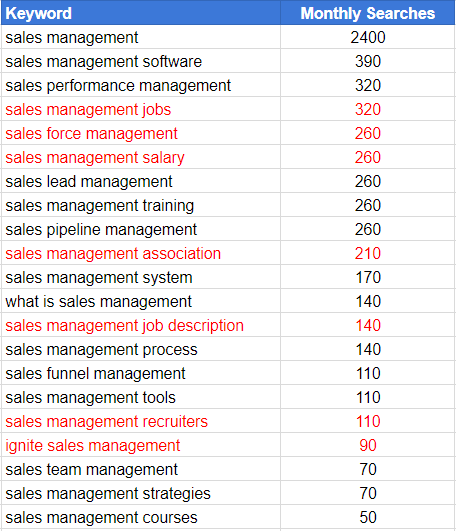
As relevant to our particular model, the red keywords should be discarded for the following reasons:
-
Job-Hunting Keywords
If the company was a job marketplace, then “job” and “recruiting” keywords would be aligned with the company’s function and target audience, but that’s not the company’s focus. Arguably, after job seekers find jobs, they might achieve C-level executive positions (the actual target audience) and need the sales management software. However, that probability is low and requires too much lead time to invest in such SEO content now. There are better opportunities with greater relevance.
-
Salary-Focused Keywords
C-level execs probably search for salary information online. Therefore, based on the audience relevance, creating content around “sales director salary” (720 monthly searches) may be useful from a traffic perspective. However, it’s too early stage, top of the funnel, low ROI, and as with the job hunting keywords, better and more relevant opportunities appear on the list.
-
Branded or Organizational Keywords
With ties to specific companies, Salesforce and Ignite (a sales consultancy) and The Sales Management Association (organization for sales professionals), the terms “sales force management,” “ignite sales management,” and “sales management association” are all branded keywords and don’t make any sense to pursue because they’re not relevant to the example company’s brand or product offering.
With the removal of keywords that don’t fit at this stage, here’s the updated list:
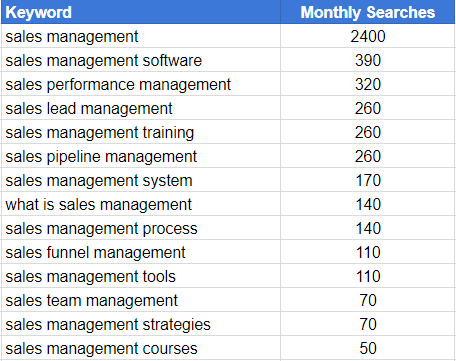
Within this example, it is also evident how there is a careful balance of investment to be negotiated. For instance, why eliminate the job and salary-focused keywords from the list but not the professional-development terms? If the job hunting keywords were discarded because the company isn’t a job marketplace, why keep terms if the company doesn’t run a sales training workshop either?
The rationale behind this choice is that someone looking to advance their career or improve their management skills, unlike the job seeker, is someone who is probably already employed. Consequently, the odds are higher that these people would need the software in their current role.
As is true for keyword targeting and decision making with SEO content strategy in general, to keep or discard is also a judgment call. The judgment process is where prioritization plays a role, as further discussed in Step 3.
While we’re keeping “sales management training,” a keyword like “sales management strategies” is more engaging from a user intent perspective (also addressed in Step 3). So, any process-driven sales strategy keywords would be prioritized over those that relate to continuing education. Similarly, “What is sales management?” is rudimentary and top of the funnel. Although one probably wouldn’t prioritize it initially, it’s surprising how often people looking to define their roles in organizations search for these basic keywords.
Step Three: Turning Keywords into a Content Strategy

With a final set of keywords, you’ll work through the lists in order to brainstorm topic ideas. As you do so, you’ll carefully consider the various content formats that you can leverage for your SEO content strategy in order to be effective for searchers at every stage of the funnel.
Top of Funnel
This content is designed to inform and educate your audience and make take one of the following forms:
- How-to posts
- Glossary-style pages
- Infographics
- Resource lists
- Round ups/group interviews
Mid-Funnel
This content focuses on providing a solution and transitioning visitors into prospects. Here are relevant formats for these purposes:
- Landing pages
- Buyer guides
- White papers
- Product demos
- Case studies
Bottom of Funnel
This content encourages prospects to become customers and may appear in the following formats:
- Free trials
- Free consultations
- Shopping carts
- Testimonials
- Special offers/coupons/discounts
Research suggests that 80% of search queries are informational, where the users are looking for facts or answers to a question, so SEO content is typically most effective at the top and mid-funnel stages. As such, content types associated with the first two stages are the ones that appear in the Google search results. To maximize visibility and drive as much traffic as possible, creating those particular content types is key.
Although the additional guidance below primarily focuses on the first two stages of the funnel, there are even more content types that can be used. So, how do you decide which content type will work best for each keyword?
Using Intent to Dictate Content Type
Search intent plays an important role in your SEO content strategy. Returning to the refined sales management list, the search intent of each of the remaining keywords falls into the transactional category or informational category.
Transactional/Commercial Keywords
These keywords have a higher level of commercial intent. If someone is searching for these keywords, they need a product (either a free or paid solution) or the evaluation of a potential solution (indicating that they have made more progress in the buying cycle).
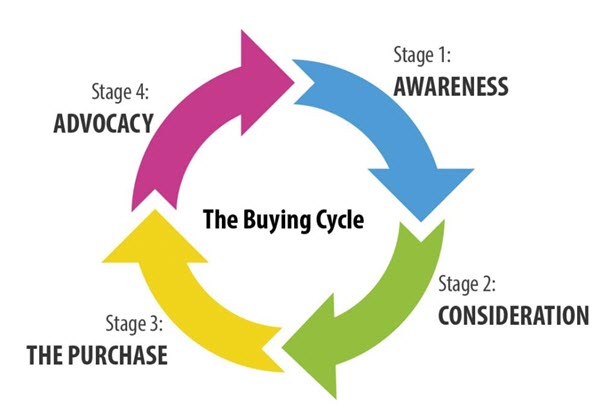
In our software company example, commercial keywords are software-focused and include sales management software and sales management tools. Consequently, the queries could deliver highly-qualified traffic from potential customers to their site with the possibility of conversion to the company and products.
Informational Keywords
Statistically, most Google searches fall into the informational search intent category, since the user’s goal is to find information on a particular topic, learn answers to a question, or glean advice on solving a problem. Although users may not actually need a product at this informational stage, the sales tool IS a potential solution, as oriented in informational keywords on our list. Essentially, individuals exploring “strategies to improve their sales process” or “ways to manage their sales pipeline,” for example, are the audience the company wants to attract to its site.
Informational terms are listed below:
#1 – sales performance management
#2 – sales lead management
#3 – sales management system
#4 – sales pipeline management
#5 – sales management process
#6 – sales funnel management
#7 – sales team management
#8 – sales management strategies
#9 – sales management
#10 – sales management training
#11 – what is sales management
#12 – sales management courses
To reiterate, search intent significantly influences topic development and mapping keywords to content topics.
Mapping Keywords to Topics
Often, the single keyword works effectively with multiple content types. For example, “#8 sales management strategies” on the above list easily evolves into a “how to do X” tips-style article, an infographic, an expert guide, or even a roundup-style group interview. However, to determine the approach that is the most ideal partner for that keyword topic, think about how to achieve the maximum SERP visibility and traffic opportunities for the site.
To determine which content type will help you reach the above goals, consider the following two key factors:
- SERP Results: The types of content Google is showing in the SERPs for a specific keyword.
- User Intent: The intent behind the keyword being searched (or more accurately how Google interprets the searcher’s intent).
Using keywords “sales management” and “sales pitch,” here’s how the above factors apply to content topic targeting.
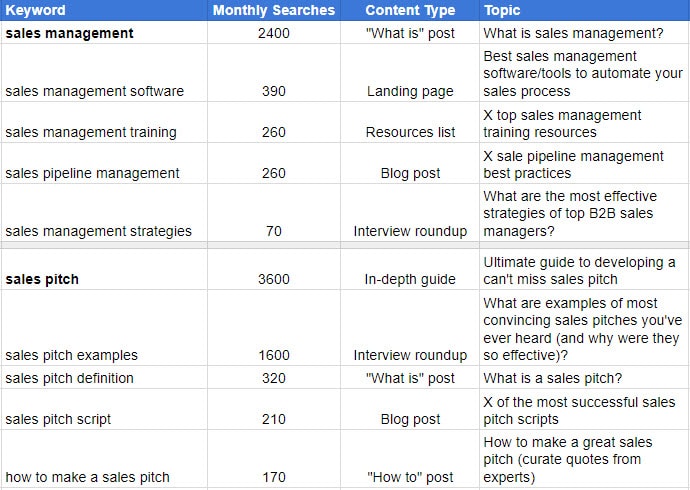
Each keyword variant has been matched with a specific content type and a possible topic. The main KPI, monthly searches, serves here to guide prioritization, unless other factors might trump demand (like buying stage, topic variety, or keyword difficulty, etc).
Now, we’ll walk through how to develop a similar chart with steps, tips, and considerations for working through the process.
Determining User Intent
| When mapping keywords to content types and topics: map informational keywords to information seeking topics, and map transactional keywords to transactional content topics. |
To determine if the user’s intent is informational or transactional, look at the SERPs. Begin by plugging your keywords into Google. Once you have the results, review exactly which types of content Google returns for specific keyword search queries. This analysis shows you how Google interprets the searcher’s intent, which reduces the guesswork in choosing the right content approach.
For instance, entering “sales management” into Google results in mainly informational listings, along with a featured snippet with the basic definition of “sales management.” Even the “People also ask” questions are simple and exploratory in nature.
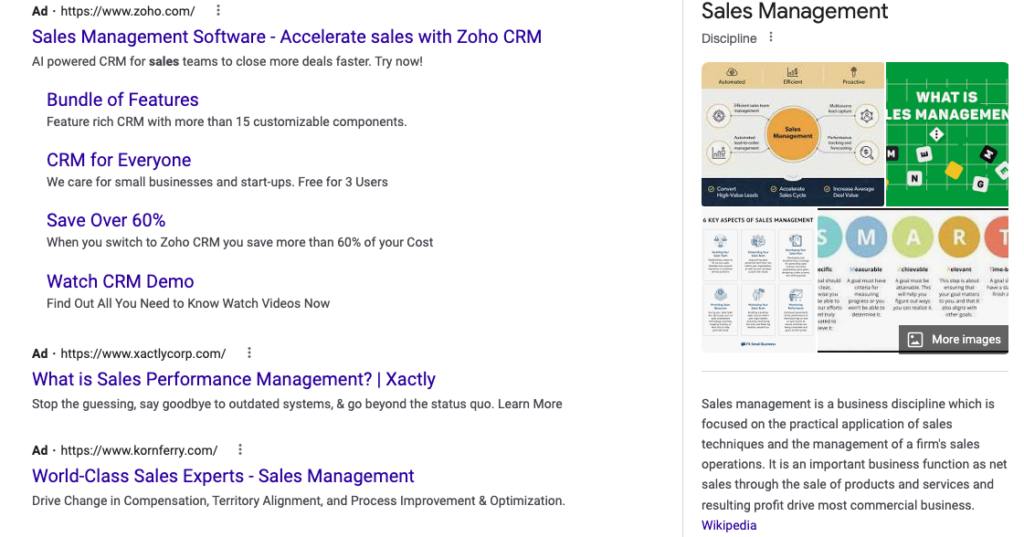
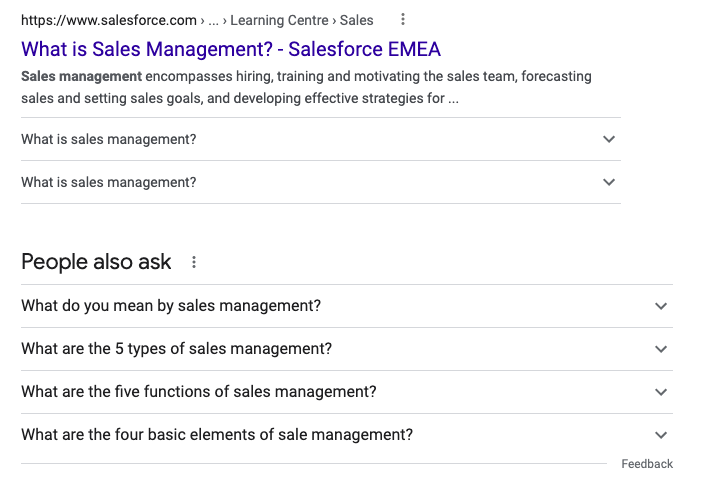
As this SERP reveals, Google thinks that individuals searching for this type of information with this basic, uncomplicated query are unfamiliar with the topic and hoping for a simple explanation. Search results focusing on sales tools or articles about expert sales strategies or listings for online courses would not correspond to the user’s intent. As such, creating a basic, glossary-style article would be more likely to be included on the SERP for “sales management” than a product-focused landing page.
Bottom line: intent is a critical factor in mapping keywords to content topics. Selecting the right content type and topic requires the understanding of user intent.
Targeting Multiple Keywords in One Content Asset
Can you target multiple keywords in the same piece of content? Yes, you can. However, limit the targeting to only a few, closely aligned keywords, or you’ll risk chasing too many keywords and producing an irrelevant document for any single keyword.
For example, it doesn’t make sense to target “sales management software” and “sales management training” in the same content. Although those keywords may appeal to the same audience, the search intent and user objective isn’t aligned. Remember: the key is understanding user intent and letting that awareness drive content. A piece that tries to target both keywords would be less effective in helping a user to quickly accomplish either objective (finding sales management software OR getting information on training options) than a high quality post on either separate subject.
Under the seed phrase “sales management training,” you can incorporate both terms in this group of semantically related variations and keyword modifiers:
#1 – Sales management training program – 50 searches per month
#2 – Sales management training courses – 30 searches per month
#3 – Sales management training seminars – 10 searches per month
Targeting each of those modifiers in the same piece of content would allow the piece to remain tightly aligned. In fact, focusing on each of those keyword variations in the same piece makes more sense than creating an individual article for each one. In this situation, multiple articles would be redundant and wouldn’t make the most effective use of your time and capital.
| You should really only target one core keyword or concept and two or three closely related variations of that keyword per piece of content. Anything more and you risk diluting the effectiveness of that content to perform well in the SERPs. |
Brainstorming Tips and Tools for Topic Ideation
Creative inspiration is helpful in developing content topics. The keyword research process alone inspires many ideas. Additionally, many of the keyword research tools help with the creative process, since they provide suggestions on similar terms that you might also target as content topics. Looking at competing sites, using SEO content idea tools, and additional ideation sources further support your topic ideation.

- Looking at competing sites for brainstorming: Analyzing competitors’ sites not only assists with keyword discovery but also helps you uncover new content topic ideas. Exploring what your competitors are doing can inspire your own creative ideas, and replicating content topics that are already performing well is an effective strategy.
- Using SEO Content Idea Tools: With any of the following resources, simply enter your SEO keywords into one or more tools to generate lists of topic ideas.
- BuzzSumo – This tool not only provides topic ideas but also shows which content assets are working well for your competitors. For tactics on use, read “How to Generate Content Ideas with Buzzsumo.”
- Answer the Public – This powerful tool reveals which questions people are actively searching. For tactics on use, read “How to Use Answer the Public to Create Better Content.”
- BloomBerry – This tool sources a range of different platforms to allow you to discover the most asked questions by your target audience. For tactics on use, read “How to Generate Content Ideas with These 3 Awesome Tools.”
- FAQ Fox – For questions based on your target keyword, this resource quickly scrapes Reddit, Quora, and Yahoo! For tactics on use, read “FAQFox Content Generation Idea Stimulating Tool.”
- Autosuggest Keyword Tool – This tool enables you to access autosuggest results simultaneously from Google, YouTube, Amazon and Bing. For tactics on use, read “‘Suggest’ Your Way to Better Content Ideas.”
- More Content Ideation Sources
- Site operators are an effective way to discover content ideas (site:examplesite.com + “target keyword”). While some of the tools above automate the process for you, the old-fashioned, advanced site operators may help you to dig deeper into individual sites, like Quora, to find commonly asked questions: site:quora.com “sales pitches”.
- Popular topics on a specific site or sites (pages with the most links, shares or visits from organic search) effectively support brainstorming ideas for your own content, specifically those topics that have proven performance with a similar audience. Ahrefs Content Explorer is a useful tool for this exploration.
- Industry events, like conferences, seminars, or conventions that are typical in nearly every industry, no matter how niche or esoteric, are fertile ground for uncovering content ideas that are in demand, current, and highly aligned with your target audience’s interests. A simple Google search easily helps you to find these industry events; once you are in attendance, focus on specific tracks, lectures, or keynote topics for ideas.
- Courses and classes are great for ideation, because they’re relevant to your audience and are generally on popular subjects. For example, Udemy is a great resource; simply use the search function to prospect for tons of courses in specific niches.
- Additional reading
Finally, these fantastic articles include even more tips on content ideation steps and techniques.
- Finding Content Ideas for SEO
- How to Come Up with 50 Content Ideas in 30 Minutes or Less
- Beginners Guide to Content Marketing Ideation
- How to Write the Perfect Lead
Prioritizing SEO Content Topics
Returning to the fictional sales software company, it is important to note that the examples shared earlier are only a handful of topic ideas to help us walk through the steps of the content strategy process. For actual clients and SEO content strategy development, more extensive keyword research to accumulate dozens or even hundreds of potential topic ideas would need to be done as part of the work in developing a long term, content marketing plan. With this necessity in mind and that many content topics to choose from, one might wonder how to prioritize ideas and decide what content to produce first.
To help establish the priority topics, consider the following factors:
- Audience Interests: Determine which topics will have the greatest appeal to and best engagement of your target audience; prioritize those and then work down the list.
- Search Demand: It’s only logical to prioritize keyword topics with the highest, demonstrated search volume first, since traffic acquisition is essential. This factor is most applicable if you’re working with an established, authoritative domain. If not, you should consider the level of difficulty.
- Competition/Level of Difficulty: By now, it is clear how valuable it is to assess the competition; the benefits of this evaluation also apply to how you prioritize. Typically, the higher the search demand the harder it is to rank. For a newer site with no domain authority, it’s better to begin by targeting terms with lower competition, instead of the most competitive keyword topics.
Our list of terms re-ranked by difficulty scores from Ahrefs illustrates the importance of considering the competition/level of difficulty factor. Difficulty score is based on the number of referring domains of the top ranking pages for a keyword.
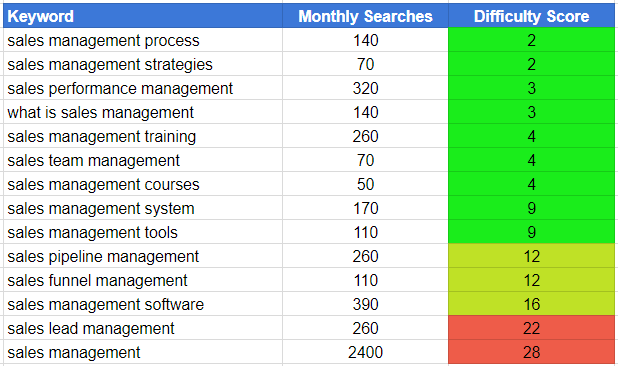
- Objectives and Goals guide prioritization as well. First and foremost, a site needs links to compete in our target SERPs. Then, prioritize resource lists or in-depth guides, which are excellent for link acquisition. If the primary objective is lead generation, then prioritize topics that are lower in the funnel.
In short, there are many factors to consider as you prioritize your content topics. You might use one or all of the above, and you might also weigh them according to your own individual approach.
Final Thoughts
Congratulations! You now have a blueprint for building out your own SEO content strategy by focusing on the key linchpin of any content game plan – finding the best keyword-driven content topics to target. Following the process outlined in this article and creating quality, value-add, SEO content on a regular basis will ensure that you see positive results. Concentrating your efforts on compelling content topics will not only increase traffic to your site on a consistent and sustained basis but also ensure that you’ll drive the right traffic to your website due to your attunement to user intent, the competition, and goal-oriented prioritization.




